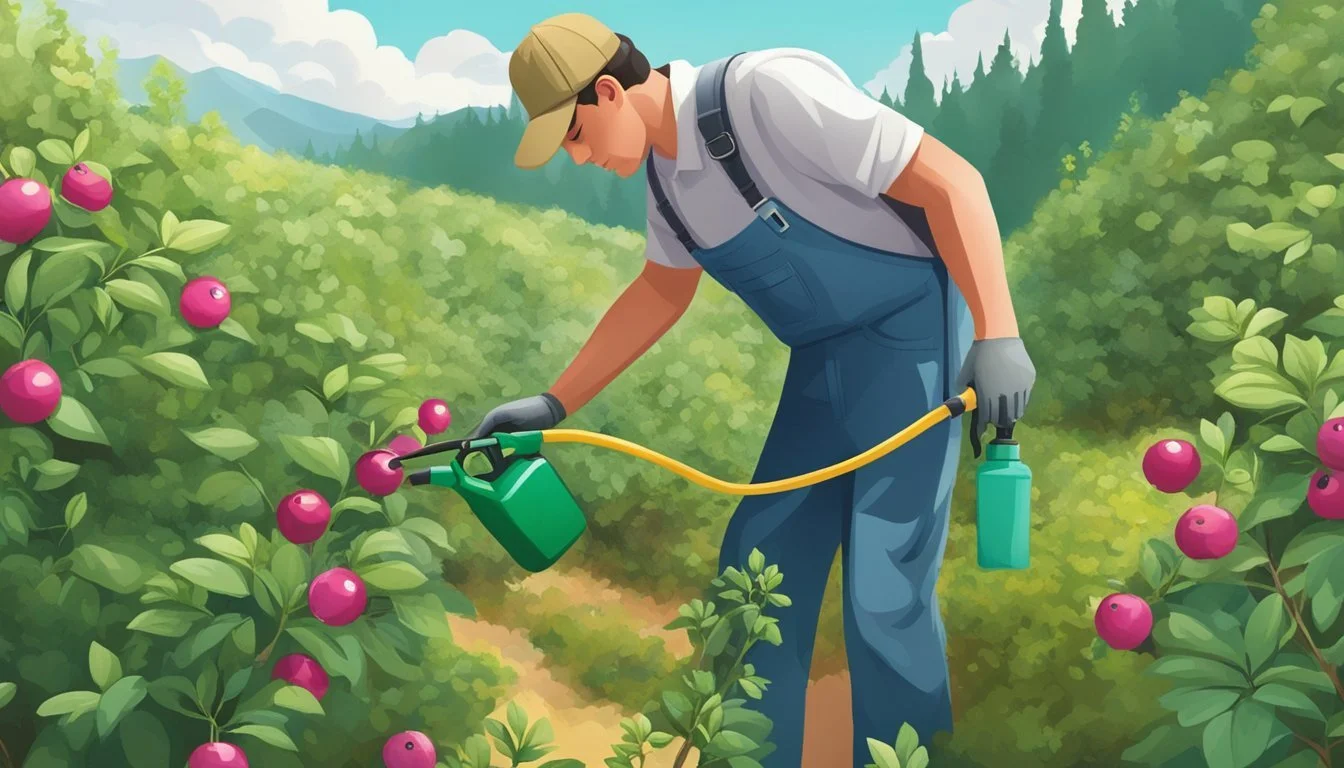Pest Control for Huckleberry Plants
Effective Strategies for Healthy Bushes
Huckleberry plants are cherished for their delicious berries and aesthetic appeal, but they can be vulnerable to a variety of pests. Effective pest control is essential for ensuring the health and productivity of these plants. Understanding the types of pests that commonly affect huckleberries and the signs of infestation is the first step in protecting these plants. From aphids to leaf-eating beetles, each pest requires a specific approach to manage and prevent damage to the foliage and fruit.
Cultural practices, such as selecting the right location for planting and proper care, play a significant role in minimizing pest outbreaks. Moreover, gardeners have various methods at their disposal to control pests, ranging from natural remedies to more targeted interventions. Strategies like washing plants with water to dislodge aphids or using companion planting can provide effective solutions without resorting to chemicals.
For those looking for a more comprehensive approach to pest control, understanding the benefits of a huckleberry trap companion plant hack or exploring the use of horticultural oils and insecticidal soaps can offer promising results. Keeping these plants healthy involves a balanced combination of preventive measures and timely interventions to ensure that gardeners can enjoy the sweet rewards of their huckleberry bushes season after season.
Understanding Huckleberry Plants
In cultivating huckleberry plants, knowing the specifics of their species, preferred soil characteristics, and environmental needs is fundamental for successful growth.
Species and Varieties
Huckleberry, encompassing diverse types, primarily includes the black huckleberry (Gaylussacia baccata) and the evergreen huckleberry (Vaccinium ovatum). The black huckleberry is known for its distinct flavor and is commonly found in the wild, favoring the acidic soils of the Eastern United States. In contrast, the evergreen huckleberry, native to the Pacific Northwest, thrives in coastal environments and offers evergreen foliage with shiny, edible berries.
Soil Requirements
Huckleberry plants require acidic soil, with a pH range of 4.5-5.5, to flourish. The ideal soil should be rich in organic matter, ensuring both proper nutrition and drainage. For optimal growth, huckleberries favor a soil environment that retains moisture without becoming waterlogged. Providing part shade to full sun exposure can also boost the plant's health and berry production, depending on the specific variety.
Designing Your Huckleberry Garden
In designing a huckleberry garden, one prioritizes layout, plant companions, and seasonal care to encourage a thriving and pest-resistant environment. Each element contributes to the overall health and productivity of the garden.
Garden Layout
When designing the layout for a huckleberry garden, maximizing sunlight and ensuring proper soil drainage are key. Huckleberries prefer acidic soil with a pH range of 4.3 to 5.2. Plan for a mix of sun and shade, considering where to plant huckleberries to get a better yield. Typically, integrating huckleberry plants towards the back of a garden or along the border can create an aesthetically pleasing backdrop that is beneficial for the plants' growth conditions.
Companion Planting
Companion planting enhances the huckleberry garden's resilience. Gardeners often plant huckleberries near vegetables that attract pests, using the huckleberries to naturally protect them. For example, incorporating huckleberries adjacent to sweet potatoes, hot peppers, and tomatoes can help deter pests from these more vulnerable plants. Adding nasturtiums and radishes around the garden's border also works as a natural pest repellent. Borage and basil are effective companions for tomatoes and can complement huckleberry plants as well by attracting beneficial pollinators.
Seasonal Care
Seasonal care for huckleberry plants includes planting seeds after the risk of frost has passed and ensuring that seedlings receive at least five hours of sunlight daily. Give huckleberries consistent moisture, and mulch to keep the roots cool and the soil moist. Native plants near the huckleberry garden can provide shelter for beneficial insects that help with pest control. As the growing season progresses, monitor your garden and adjust care, whether it's adding organic mulch or pruning overgrown plants.
Pest Management Strategies
Effective pest management in huckleberry cultivation hinges on preemptive actions, natural solutions, and judicious chemical interventions. Each strategy plays a pivotal role in preserving the health and productivity of huckleberry plants.
Preventive Measures
Preventive actions are fundamental to minimizing infestations in huckleberry gardens. Cultivators should consider:
Site selection and maintenance: Opting for well-draining soil and maintaining cleanliness around plants can deter the proliferation of slugs and other garden pests.
Crop rotation and diversity: Planting a variety of species, such as dill and catnip, can attract beneficial insects, like ladybugs and lacewings, which are natural predators of aphids and other pests.
Natural Pest Control Options
When pests do invade, natural pest control strategies can address them without harming the ecosystem:
Biological control agents: Introducing parasitic wasps and predatory birds can keep caterpillar and beetle populations in check.
Botanicals: Sprays made from neem oil and artemisia extracts can effectively target pests like spider mites and Japanese beetles.
Pesticides and Chemical Control
While chemicals are available, they should be used as a last resort:
Targeted application: Specific pesticides, designed to combat challenging pests such as flea beetles and thrips, should be used sparingly.
Compliance with regulations: Adhering to safety guidelines ensures minimal impact on the environment and non-target species, including deer and other wildlife.
Common Pests and Problems
Huckleberry plants, although hardy, can succumb to various pests and issues. The following focuses on specific challenges such as insect pests, wildlife interference, and diseases that may arise during cultivation.
Insect Pests
Insect infestations can significantly affect huckleberry plant health. Aphids are small sap-sucking insects that can cause leaves to pucker and stunt growth. Ants may be seen around aphid populations as they are attracted to the honeydew aphids produce. Beetles, including the destructive Japanese beetle, feed on plant foliage, leading to ragged leaves. Another common pest, caterpillars, may consume large amounts of leaf material, while slugs often leave irregular holes in the leaves. Whiteflies are also pests that can cause issues for huckleberries by sucking plant juices and inducing leaf yellowing.
Critters and Wildlife
Larger animals such as rabbits and deer pose risks to huckleberry plants, often nibbling on tender shoots and leaves. Critters like these can quickly devastate a crop, especially in the fall when other food sources are scarce. To provide protection for huckleberry plants, physical barriers such as fencing can be effective.
Diseases and Disorders
Diseases can also trouble huckleberry bushes. Poor cultural practices, such as over-fertilizing, can lead to various disorders. Ensuring that plants receive balanced nutrients without excess can prevent issues related to improper fertilization. It is important to inspect plants regularly for signs of disease and to implement appropriate measures quickly to maintain a pest-free environment.
Cultural Practices for Pest Control
Incorporating cultural practices into huckleberry plant care is an effective strategy for managing pests. Through specific cultivation techniques, one can foster a less appealing environment for pests, making these methods a cornerstone of sustainable horticulture.
Crop Rotation and Diversity
Implementing crop rotation helps minimize pest problems by disrupting the life cycle of insects and diseases associated with huckleberries. For instance, alternating huckleberry plots with unrelated crops can significantly reduce the presence of specialized pests. Adding diversity with companion plants provides additional benefits by attracting beneficial insects and providing a physical barrier to pest migration.
Key Actions:
Avoid planting huckleberries in the same soil consecutively.
Introduce different crop species that complement the huckleberries.
Soil Health and Fertilization
Optimal soil health forms the basis of a robust huckleberry crop less prone to pest pressures. Conducting a soil test to assess nutrient levels and pH can inform proper fertilization practices. Enriching the soil with the right balance of nutrients and organic matter, like compost or well-rotted manure, strengthens plants' natural defenses.
Fertilization Tips:
Apply fertilizers based on soil test recommendations to avoid over-fertilization that can favor pests.
Incorporate mulch to maintain soil moisture and temperature, further deterring pest infestation.
Physical and Mechanical Controls
Physical and mechanical pest control strategies effectively protect huckleberry plants by creating a barrier against pests and facilitating the direct removal of pests without the use of chemicals.
Protective Barriers
Netting and mesh fences are essential in safeguarding huckleberry plants from birds and insects. Specifically, a fine mesh netting can prevent access to the berries, while still allowing sunlight and rain to reach the plants. Moreover, installing a mesh fence around the garden can thwart larger pests such as deer or rabbits.
Row covers, another form of protective barrier, offer an excellent defense not only against pests but also against extreme weather conditions. When it comes to huckleberry cultivation, lightweight row covers can be used during the fruiting season to ensure the ripening fruit is protected from insects.
Manual Pest Removal
Manual pest removal involves regularly inspecting huckleberry plants and hand-picking pests such as caterpillars or beetles. This method can be particularly efficient when combined with daily harvesting, as it allows the gardener to monitor the overall health of the plants and the ripeness of the berries.
It's important to remove pests promptly and to regularly check under leaves and near the soil, as many pests tend to hide in these areas. For larger huckleberry plots, mechanical devices like suction tools can aid in the removal process, making it more manageable.
Biological Pest Control
Biological pest control is a method that utilizes natural predators and beneficial organisms to manage pest populations in a sustainable and environmentally friendly manner. This strategy is particularly effective for huckleberry plants, which can be susceptible to various pests.
Beneficial Insects and Animals
Ladybugs: Ladybugs are voracious consumers of aphids, a common pest of huckleberry plants. A single ladybug can eat dozens of aphids per day, making them a gardener's ally.
Lacewings: Green lacewings are also beneficial for huckleberry plants, as their larvae have the capacity to consume a substantial number of aphids and other soft-bodied insects.
Birds: Many bird species feed on pests that harm huckleberry bushes. Encouraging birds to visit the garden by providing nesting sites can enhance this natural predation.
Parasitic Wasps: These wasps lay their eggs on or inside pest insects, and the hatching larvae consume their host. Parasitic wasps are integral in controlling huckleberry pests without harming the plants.
Integrated Pest Management
Integrated Pest Management (IPM) is a comprehensive approach that combines biological controls with cultural practices and, when necessary, judicious use of pesticides. Below is an outline of how IPM may be employed with huckleberry plants:
Monitor and Identify Pests: Regularly check huckleberry plants to correctly identify and understand the life cycle of pests present.
Biological Controls: Introduce beneficial insects like ladybugs and parasites that specifically target and control huckleberry pests.
Cultural Practices: Employ methods such as crop rotation, pruning, and proper waste management to reduce pest habitats.
Chemical Control (if needed): Use pesticides as a last resort and choose products that are least harmful to beneficial organisms.
Implementing IPM offers a systematic method to control pests by combining natural predators with practical gardening techniques, ensuring the health of huckleberry plants while maintaining ecological balance.
Cultivation and Harvesting
Cultivating huckleberry plants requires understanding their growth habits and environmental needs, whereas harvesting the fruit demands precise timing and technique to ensure yield and flavor.
Best Practices
Huckleberry plants thrive in acidic, well-draining soil with a pH between 4.5 and 6, and they prefer locations with adequate sunlight. Incorporating organic matter into the soil can improve its structure and nutrient content, which is beneficial for the plants. Regular watering is essential, particularly as the plants establish themselves and during dry periods, but overwatering should be avoided to prevent root rot. A key aspect of huckleberry cultivation is protecting the plants from pests without using harsh chemicals, as indicated by the pest-free garden hack.
Timing and Techniques
The harvesting of huckleberry fruit generally occurs in late summer to early fall when the berries have turned a deep blue or purple-black and are plump. Berries should be picked carefully by hand to avoid damaging the plant and fruit. It is essential to frequently check on the plants throughout the harvesting season since huckleberries do not all ripen at once. For best results, the berries should be processed or consumed shortly after harvesting to maintain their flavor and nutritional value.
Garden Maintenance and Aftercare
Proper garden maintenance and aftercare are crucial for cultivating healthy huckleberry plants and minimizing pest problems. Focused attentiveness to seasonal cleanup and regular pruning and trimming can help keep the garden balanced, productive, and as pest-free as possible.
Seasonal Cleanup
After the growing season ends, gardeners should prioritize the removal of fallen leaves and debris from around their huckleberry plants. This not only deters pests who might overwinter in the detritus but also reduces the likelihood of fungal diseases. In fall, a thorough cleanup is particularly important to prepare the plants for the next growing cycle.
Pruning and Trimming
Pruning and trimming huckleberry plants improve air circulation and sunlight penetration, which are essential for a healthy garden. During the dormant season, usually in late winter to early spring, one should carefully remove any dead or diseased branches. Keeping the plants well-groomed prevents excess moisture buildup on the leaves, a condition which attracts pests and can lead to disease.
Additional Resources and Support
For those looking to bolster their knowledge in sustainable pest management, particularly for huckleberry plants, a wealth of information can be accessed through various channels. One can leverage educational workshops or engage with community gardening groups to further understand the intricacies of horticulture.
Educational Workshops
Educational workshops provide hands-on learning opportunities, often facilitated by experts in the field. They are an invaluable resource for gardeners aiming to adopt organic pest control methods for huckleberry plants. These workshops cover a range of topics, from plant selection to pest identification, and provide actionable strategies. Participants gain practical skills such as how to incorporate huckleberry companion planting techniques to deter pests.
Community Gardening Groups
Community gardening groups are a hub for sharing knowledge and resources. Gardeners can connect with their peers, exchange tips on huckleberry cultivation, and collaborate to tackle common pest challenges. These groups often maintain an active presence online and may host meetings where members discuss topics like the use of huckleberry trap plant hacks. Through such interactions, one can draw on the collective wisdom and experience of the community to enhance their gardening practices.










